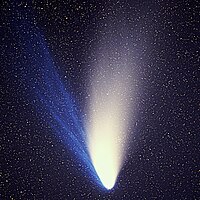
Photo from wikipedia
The aim of the present paper is to study the dynamics of a class of orbitally continuous non-linear mappings defined on the set of real numbers and to apply the… Click to show full abstract
The aim of the present paper is to study the dynamics of a class of orbitally continuous non-linear mappings defined on the set of real numbers and to apply the results on dynamics of functions to obtain tests of divisibility. We show that this class of mappings contains chaotic mappings. We also draw Julia sets of certain iterations related to multiple lowering mappings and employ the variations in the complexity of Julia sets to illustrate the results on the quotient and remainder. The notion of orbital continuity was introduced by Lj. B. Ciric and is an important tool in establishing existence of fixed points. To the memory of Professor Lj. Ćirić (1935–2016) 1. Definitions and Preliminaries A discrete dynamical system consists of a function and its iterates. We call the behaviour of points under iteration of a function the dynamics of the function. We first give some well known definitions relevant to our work. Definition 1.1. If f is a function, the orbit of a point x is the set of points x, f (x), f 2(x), f 3(x), f 4(x), . . . where f 2x denotes f ( f (x)), f 3(x) denotes f ( f ( f (x))) etc. Orbits can be quite complicated sets even for simple mappings. However, orbits associated with fixed points and periodic points are especially simple and these play a central role in the study of an entire system. Definition 1.2. The point x is called a fixed point of f if f (x) = x. A point x is called a periodic point of period n if f n(x) = x. The least positive integer n for which f n(x) = x is called the prime period of x. The prime period need not be a prime number (see Example 1.4 given below). The set of all iterates of a periodic point forms a periodic orbit. Definition 1.3. A point x is an eventually fixed point of f if there exists an integer N > 0 such that f (n+1)(x) = f n(x) for n ≥ N. A point x is eventually periodic of period k if there exists N > 0 such that f (n+k)(x) = f n(x) for n ≥ N. Example 1.4 ([2, 3]). Let S1 denote the unit circle in the xy-plane and identify each point on the circle by the radian measure in a counter-clockwise direction of the angle between the positive x-axis and the ray beginning at the origin 2010 Mathematics Subject Classification. Primary 37C25, 37F10, 37F15, 37N99
Journal Title: Filomat
Year Published: 2017
Link to full text (if available)
Share on Social Media: Sign Up to like & get
recommendations!